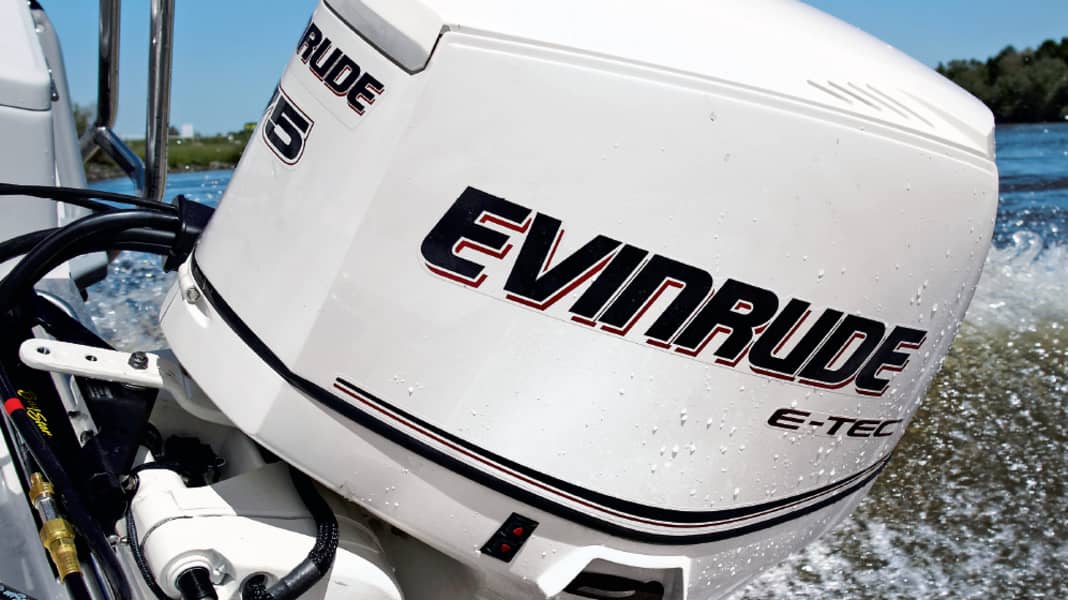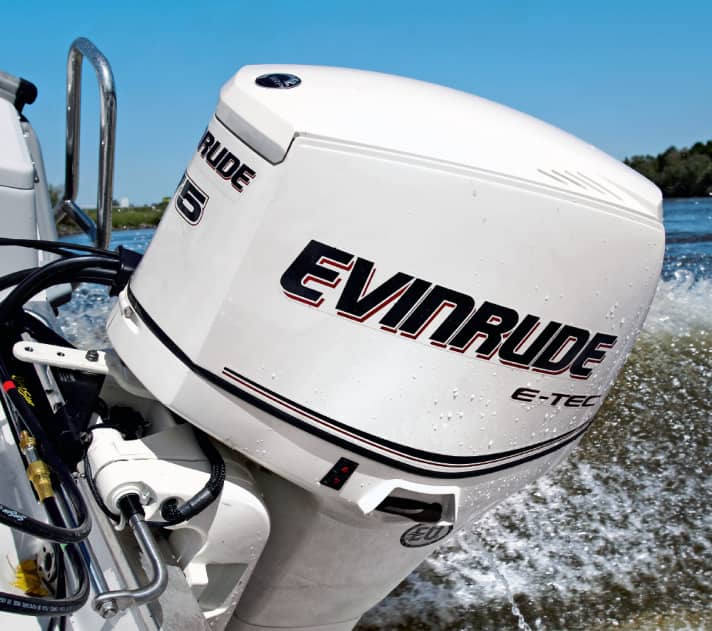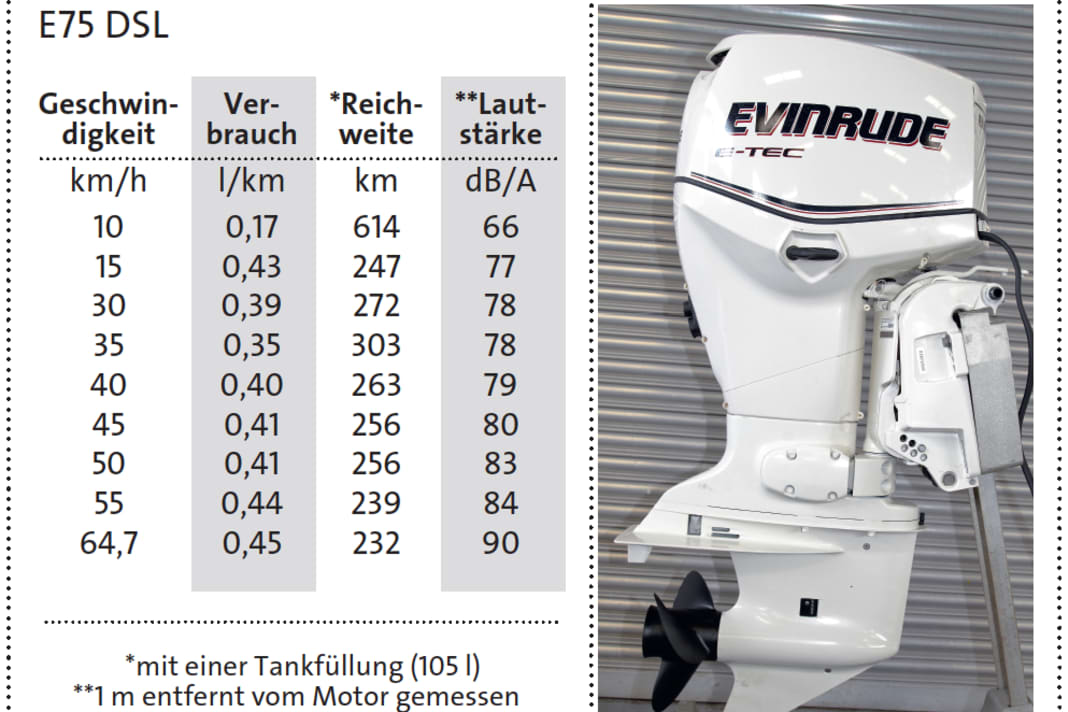
THIS IS THEPART 2 OF OUR COMPARATIVE TEST OF OUTBOARDS FROM 70 TO 75 HP. PART 1 WITH THE MODEL OVERVIEW YOU CAN FIND HERE.







We let each engine manufacturer determine the mounting height and the choice of propeller on the test boat themselves, because everyone has their own philosophy and knows what their engine can or should be able to do. For this test, we used the workshop facilities of the "Sportbootambulanz" company under the management of Jörn Lässig in Kahl am Main for the assembly work. As always, the boat was launched on the grounds of Marina Lässig directly on the Main; thanks to years of co-operation, owner Heike Roth now knows the first names of the BOOTE test crew. The section of the Main in Kahl offers consistent conditions, which is essential for such a test.
The aforementioned free choice of propeller also includes whether a stainless steel, steel or aluminium propeller is fitted. Evinrude, Mercury, Suzuki, Tohatsu and Yamaha include aluminium propellers as standard, which the dealer will match to the boat. If you want a stainless steel propeller, you pay extra. Honda supplies its engine without a propeller; this must be purchased separately.
Only the 70 hp "weak" Yamaha struggled a little when switching from displacement to planing speed. The ready-to-run boat with engine and crew weighs between 951 kg and 999 kg, depending on which engine is attached to the transom. While the bow of the Hawk only lifted briefly with the test engines and had little effect on the foresight before it lowered again, this process took longer with the F70.
This becomes clearer with the acceleration values. Evinrude accelerates the Silver Hawk 540 CC to 50 km/h in just 6.9 s, whereas the Yamaha takes more than twice as long. All other engines, whether two or four-stroke, 70 or 75 hp, need between 7.6 and 8.6 s to sprint from a standstill to 50 km/h.
Important: When accelerating, the motor must initially always be trimmed all the way to the transom. As the speed increases, it must be trimmed up further and further for an optimum trim position. The Suzuki completes the sprint to 35 km/h in just 4.1 seconds, closely followed by Evinrude with a difference of two tenths and Mercury, tied with Honda's BF75 in third place at 4.4 seconds. With the 3 x 13 1/2" x 16" steel propeller, Yamaha is clearly lagging behind when accelerating.
The same applies to the top speed. The 56.8 km/h achieved put the F70 in last place. The E75 from Evinrude with a 3-x-13-1/2"-x-17" stainless steel propeller was a full 8.1 km/h faster. Honda had also fitted a stainless steel propeller, but with a different pitch due to the gear ratio. We measured 63.4 km/h, which means second place. Identical gear ratios and propeller dimensions, but made of aluminium, were installed on the Mercury and Tohatsu; the top speed of both engines is also identical. With the 62.2 km/h achieved, they share third place in the speed ranking.
However, acceleration and top speed are not everything. Consumption and noise levels are usually more important. This is where the "little" Yamaha was able to show its strengths. At full load, the F70 consumes 105 litres of fuel with a consumption of 0.36 l/km after a distance of 293 km - which gives the Yamaha another plus point. Second place with a respectable 265 km goes to Mercury, followed by Suzuki in third place with 246 km. In terms of noise at full load, Honda shines with the lowest value of all. 88 dB/A and thus 3 dB/A louder than the Honda is the Yamaha. The difference to the third-placed Mercury is only 1 dB/A.
Driving a glider economically means travelling fast and economically at the same time. The most economical speed for the Silver Hawk and Yamaha E70 combination is 35 km/h. If you drive at this speed, 0.27 litres/km flow through the injection nozzles and one tank of fuel lasts for 386 km. In terms of noise, the noise level is 76 dB/A, which is also the lowest value. The Honda achieves an economical speed of 40 km/h. The range is 367 km with a fuel consumption of 0.29 l/km. At 78 dB/A on the measurement scale, it is also pleasantly quiet. The OptiMax from Mercury was surprising. Two-strokes are regarded as "booze goats", which we cannot confirm based on the measurement results. If you glide over the water at 40 km/h, 0.30 litres/km flow through the fuel line. The 81 dB/A produced by the engine is also acceptable.
Conclusion: Honda shows that it pays to fit a stainless steel propeller, and the Evinrude can defend its title as the fastest engine. Engine manufacturer Mercury proves that even two-stroke engines can be economical and quiet these days. If you want a lightweight engine with low fuel consumption and low noise, but without sprinter characteristics, the Yamaha E70 is a good choice. If you prefer to travel fast and fuel consumption and noise levels do not play a major role, the low-maintenance and affordable Evinrude is recommended. Honda's BF75 is positioned in the upper segment in every category; here you get a real all-rounder at a price of 9900 euros plus propeller.

